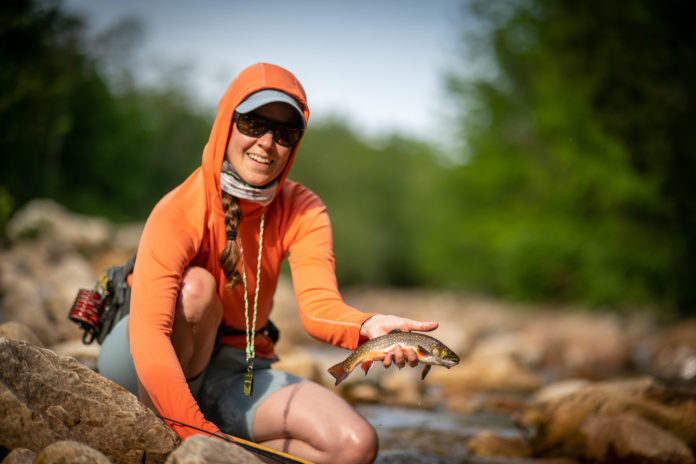Written by Phil Monahan
Photos by Drew Nisbet
Since it’s wet-wading season in much of the country, we’re talking about the best gear to make the most of your time while fishing wader-free. Last week, we covered what to wear–from head to toe–to make sure you stay upright on slippery rocks and protected from the sun. Now it’s time to turn our attention to the actual fishing tackle that makes warm-weather fly-fishing so much fun.
Fly Rods

For summertime wet-wading, your choice of fly rod will be based on several factors, including
- the size of the stream or river,
- the size of the fish you’re after,
- the size of the flies you’ll be casting,
- and the prevailing conditions.
For instance, if you’re planning to fish the Madison on a windy day, casting a big hopper-dropper rig, you’ll want a 6-weight with enough backbone to turn over the tandem rig. For a tiny, brush-choked Driftless Area stream where the trout are eating sulfurs, you might opt for a 7½-foot 3-weight, so you can make tight, short casts and delicate presentations.
When I am fishing the freestone mountain streams of southern Vermont, I only fish dry flies, and my main consideration is how much reach I am going to need to get a good presentation. For smaller streams with long pools, I generally go with my 7½-foot 3-weight Superfine Glass rod, but for rockier streams with lots of plunge pools, I need some extra reach to keep my fly line out of the many conflicting currents. That’s when I pull out the 9-foot 4-weight Recon, which allows me to reach over boulders and lay just the leader and fly on the water.
Fly Lines and Leaders

The same considerations listed above should guide your choices of lines and leaders, as well. Unless the conditions are flat-calm, I always opt for a weight-forward floating line, which helps to punch through any wind and also allows me to cast with just a couple feet of fly line outside the tip-top of the rod. When I’m dropping a Stimulator into seams, slots, and plunge pools of a boulder-strewn brook-trout stream, I want to be able to cast short, get a good drift, and then dry my fly with two quick false casts. The extra weight at the tip of a WF line makes that possible. That said, if you’re fishing the Driftless stream above at dawn, when the air is flat, a double-taper line might offer more delicate presentations.
For our Madison example above, you’ll need a leader stout enough to turn over a bushy dry and a nymph in the wind. A 9-foot 3X leader to the dry and 4X dropper will probably do the trick. If you’re fishing flat water or smaller patterns, you may need to go one size smaller for each. When I’m on a mountain stream, I start with a 7½-foot 4X leader, to which I add 18 inches of 5X. The fish are generally not spooky, but lighter tippet is less affected by swirling water. If I add a dropper to the dry fly, I step down to 6X.
Flies

Fly choice isn’t really affected by whether you’re wet-wading or not, but I couldn’t talk about fishing mountain freestone streams without sharing some of my favorite patterns. This is rarely a hatch-matching opportunity, and I almost never see trout rising, except at dusk. In most cases, the fish have very little time to inspect your offering, so I focus on impressionistic patterns that look buggy and represent several possible foodstuffs. Here are my go-to drys.
The same goes for nymphs. Unlike Tom Rosenbauer, who almost always starts with a dry-dropper set up, I prefer to catch mountain trout on dry flies, adding a dropper only when I’m convinced that the surface patterns aren’t doing the trick. As with the selection above, I use generic patterns, except for the sunken-ant imitation, which I find very effective in the middle of the day. The bushier dry flies work best with the beadhead nymphs.
Packs and Bags

One of the joys of wet-wading is shedding cumbersome waders, so why would you wear a full vest or carry a big bag? I prefer to travel fast and light, using a lightly-packed Orvis Safe Passage Sling Pack. It’s got enough room for two or three fly boxes, a water bottle, and a light rain jacket. It’s also got places for all my tools and a net, which I like to carry to avoid bashing trout against in-stream rocks. Just as important, it gives me a place to put my keys, wallet, and phone, so I don’t have to worry about wading too deep.
When I fished with my colleague Chrissy Atkins recently, she was sinking the praises of her Waterproof Hip Pack (see above), which keeps the weight off her shoulders and back. Another option is the Safe Passage Chip Pack (Chip=Chest + Hip), which is slightly larger and can be worn on the hip or as a chest pack.
Click here to read Part I
Click here to see the Orvis Wet-Wading Collection
Credit: Source link






























